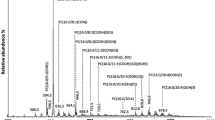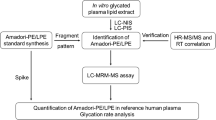Abstract
N-monomethyl phosphatidylethanolamine (MMPE) and N,N-dimethyl phosphatidylethanolamine (DMPE) species are intermediates of phosphatidylcholine (PC) de-novo biosynthesis through methylation of phosphatidylethanolamine (PE). This synthesis pathway for PC is especially important in the liver when choline is deficient in the diet. Despite some efforts focused on the analysis of MMPE and DMPE species, a cost-effective and high-throughput method for determination of individual MMPE and DMPE species, including their regioisomeric structures, is still missing. Therefore we adopted and improved the “mass-tag” strategy for determining these PE-like species by methylating PE, MMPE, and DMPE molecules with deuterated methyl iodide to generate PC molecules with nine, six, and three deuterium atoms, respectively. On the basis of the principles of multidimensional mass-spectrometry-based shotgun lipidomics we could directly identify and quantify these methylated PE species, including their fatty-acyl chains and regiospecific positions. The method provided remarkable sensitivity, with a limit of detection at 0.5 fmol μL−1, high specificity, and a broad linear-dynamics range of >2500 folds. By applying this method to liver samples from streptozotocin (STZ)-induced diabetic mice and controls, we found that the levels of PC species tended to decrease and the amounts of PE species tended to increase in the liver of STZ-induced diabetic mice compared with controls, but no significant changes in MMPE and DMPE species were determined. However, remodeling of fatty-acyl chains in the determined lipids was observed in the liver of STZ-induced diabetic mice, with reduction in 16:1 and increases in 18:2, 18:1, and 18:0 acyl chains. These results indicated the improved method to be a powerful tool to reveal the function of the PC de-novo biosynthesis pathway through methylation of PE species in biological systems.

Representative mass spectra of PC, MMPE, DMPE, and PE species present in mouse liver samples




Similar content being viewed by others
References
van Meer G (2005) Cellular Lipidomics. EMBO J 24:3159–3165
Han X, Gross RW (2005) Shotgun Lipidomics: Electrospray Ionization Mass Spectrometric Analysis and Quantitation of the Cellular Lipidomes Directly from Crude Extracts of Biological Samples. Mass Spectrom Rev 24:367–412
Cole LK, Vance JE, Vance DE (2012) Phosphatidylcholine Biosynthesis and Lipoprotein Metabolism. Biochim Biophys Acta 1821:754–761
Sprong H, van der Sluijs P, van Meer G (2001) How Proteins Move Lipids and Lipids Move Proteins. Nat Rev Mol Cell Biol 2:504–513
Lagace TA, Ridgway ND (2013) The Role of Phospholipids in the Biological Activity and Structure of the Endoplasmic Reticulum. Biochim Biophys Acta 1833:2499–2510
Vance JE, Vance DE (1985) The Role of Phosphatidylcholine Biosynthesis in the Secretion of Lipoproteins from Hepatocytes. Can J Biochem Cell Biol 63:870–881
Israelsson B, Brattstrom LE, Hultberg BL (1988) Homocysteine and Myocardial Infarction. Atherosclerosis 71:227–233
Wierzbicki AS (2007) Homocysteine and Cardiovascular Disease: A Review of the Evidence. Diab Vasc Dis Res 4:143–150
Landgren F, Israelsson B, Lindgren A, Hultberg B, Andersson A, Brattstrom L (1995) Plasma Homocysteine in Acute Myocardial Infarction: Homocysteine-Lowering Effect of Folic Acid. J Intern Med 237:381–388
Li Z, Agellon LB, Allen TM, Umeda M, Jewell L, Mason A, Vance DE (2006) The Ratio of Phosphatidylcholine to Phosphatidylethanolamine Influences Membrane Integrity and Steatohepatitis. Cell Metab 3:321–331
Song J, da Costa KA, Fischer LM, Kohlmeier M, Kwock L, Wang S, Zeisel SH (2005) Polymorphism of the Pemt Gene and Susceptibility to Nonalcoholic Fatty Liver Disease (Nafld). FASEB J 19:1266–1271
da Costa KA, Kozyreva OG, Song J, Galanko JA, Fischer LM, Zeisel SH (2006) Common Genetic Polymorphisms Affect the Human Requirement for the Nutrient Choline. FASEB J 20:1336–1344
Schwudke D, Oegema J, Burton L, Entchev E, Hannich JT, Ejsing CS, Kurzchalia T, Shevchenko A (2006) Lipid Profiling by Multiple Precursor and Neutral Loss Scanning Driven by the Data-Dependent Acquisition. Anal Chem 78:585–595
Han X, Yang K, Cheng H, Fikes KN, Gross RW (2005) Shotgun Lipidomics of Phosphoethanolamine-Containing Lipids in Biological Samples after One-Step in Situ Derivatization. J Lipid Res 46:1548–1560
Bilgin M, Markgraf DF, Duchoslav E, Knudsen J, Jensen ON, de Kroon AI, Ejsing CS (2011) Quantitative Profiling of Pe, Mmpe, Dmpe, and Pc Lipid Species by Multiple Precursor Ion Scanning: A Tool for Monitoring Pe Metabolism. Biochim Biophys Acta 1811:1081–1089
Buckell M (1950) The Toxicity of Methyl Iodide: I. Preliminary Survey. Br J Ind Med 7:122–124
Chamberlain MP, Sturgess NC, Lock EA, Reed CJ (1999) Methyl Iodide Toxicity in Rat Cerebellar Granule Cells in Vitro: The Role of Glutathione. Toxicology 139:27–37
Han X, Gross RW (2005) Shotgun Lipidomics: Multi-Dimensional Mass Spectrometric Analysis of Cellular Lipidomes. Expert Rev Proteomics 2:253–264
Han X, Yang K, Gross RW (2012) Multi-Dimensional Mass Spectrometry-Based Shotgun Lipidomics and Novel Strategies for Lipidomic Analyses. Mass Spectrom Rev 31:134–178
Han X, Abendschein DR, Kelley JG, Gross RW (2000) Diabetes-Induced Changes in Specific Lipid Molecular Species in Rat Myocardium. Biochem J 352:79–89
Yang K, Cheng H, Gross RW, Han X (2009) Automated Lipid Identification and Quantification by Multi-Dimensional Mass Spectrometry-Based Shotgun Lipidomics. Anal Chem 81:4356–4368
Yang K, Han X (2011) Accurate Quantification of Lipid Species by Electrospray Ionization Mass Spectrometry - Meets a Key Challenge in Lipidomics. Metabolites 1:21–40
Christie WW, Han X (2010) Lipid Analysis: Isolation, Separation, Identification and Lipidomic Analysis. The Oily Press, Bridgwater
Han X, Yang K, Gross RW (2008) Microfluidics-Based Electrospray Ionization Enhances Intrasource Separation of Lipid Classes and Extends Identification of Individual Molecular Species through Multi-Dimensional Mass Spectrometry: Development of an Automated High Throughput Platform for Shotgun Lipidomics. Rapid Commun Mass Spectrom 22:2115–2124
Yang K, Zhao Z, Gross RW, Han X (2009) Systematic Analysis of Choline-Containing Phospholipids Using Multi-Dimensional Mass Spectrometry-Based Shotgun Lipidomics. J Chromatogr B 877:2924–2936
Guo M, Gao S (2009) Degradation of Methyl Iodide in Soil: Effects of Environmental Factors. J Environ Qual 38:513–519
Han X, Yang J, Cheng H, Ye H, Gross RW (2004) Towards Fingerprinting Cellular Lipidomes Directly from Biological Samples by Two-Dimensional Electrospray Ionization Mass Spectrometry. Anal Biochem 330:317–331
Han RH, Wang M, Fang X, Han X (2013) Simulation of Triacylglycerol Ion Profiles: Bioinformatics for Interpretation of Triacylglycerol Biosynthesis. J Lipid Res 54:1023–1032
Simoes C, Domingues P, Ferreira R, Amado F, Duarte JA, Vitorino R, Neuparth MJ, Nunes C, Rocha C, Duarte I, Domingues MR (2013) Remodeling of Liver Phospholipidomic Profile in Streptozotocin-Induced Diabetic Rats. Arch Biochem Biophys 538:95–102
Yang K, Fang X, Gross RW, Han X (2011) A Practical Approach for Determination of Mass Spectral Baselines. J Am Soc Mass Spectrom 22:2090–2099
Han X, Gross RW (2003) Global Analyses of Cellular Lipidomes Directly from Crude Extracts of Biological Samples by Esi Mass Spectrometry: A Bridge to Lipidomics. J Lipid Res 44:1071–1079
Puri P, Baillie RA, Wiest MM, Mirshahi F, Choudhury J, Cheung O, Sargeant C, Contos MJ, Sanyal AJ (2007) A Lipidomic Analysis of Nonalcoholic Fatty Liver Disease. Hepatology 46:1081–1090
Fernando H, Bhopale KK, Kondraganti S, Kaphalia BS, Shakeel Ansari GA (2011) Lipidomic Changes in Rat Liver after Long-Term Exposure to Ethanol. Toxicol Appl Pharmacol 255:127–137
Pan HJ, Lin Y, Chen YE, Vance DE, Leiter EH (2006) Adverse Hepatic and Cardiac Responses to Rosiglitazone in a New Mouse Model of Type 2 Diabetes: Relation to Dysregulated Phosphatidylcholine Metabolism. Vasc Pharmacol 45:65–71
Douillet C, Bost M, Accominotti M, Borson-Chazot F, Ciavatti M (1998) Effect of Selenium and Vitamin E Supplements on Tissue Lipids, Peroxides, and Fatty Acid Distribution in Experimental Diabetes. Lipids 33:393–399
Rajasekaran S, Ravi K, Sivagnanam K, Subramanian S (2006) Beneficial Effects of Aloe Vera Leaf Gel Extract on Lipid Profile Status in Rats with Streptozotocin Diabetes. Clin Exp Pharmacol Physiol 33:232–237
Acknowledgments
This work was partly supported by the National Institute of General Medical Sciences Grant R01 GM105724 and Intramural institutional research funds.
Author information
Authors and Affiliations
Corresponding author
Additional information
Published in the topical collection Lipidomics with guest editor Michal Holčapek.
Electronic supplementary material
Below is the link to the electronic supplementary material.
ESM 1
(PDF 121 kb)
Rights and permissions
About this article
Cite this article
Wang, M., Kim, G.H., Wei, F. et al. Improved method for quantitative analysis of methylated phosphatidylethanolamine species and its application for analysis of diabetic-mouse liver samples. Anal Bioanal Chem 407, 5021–5032 (2015). https://doi.org/10.1007/s00216-015-8534-4
Received:
Revised:
Accepted:
Published:
Issue Date:
DOI: https://doi.org/10.1007/s00216-015-8534-4




